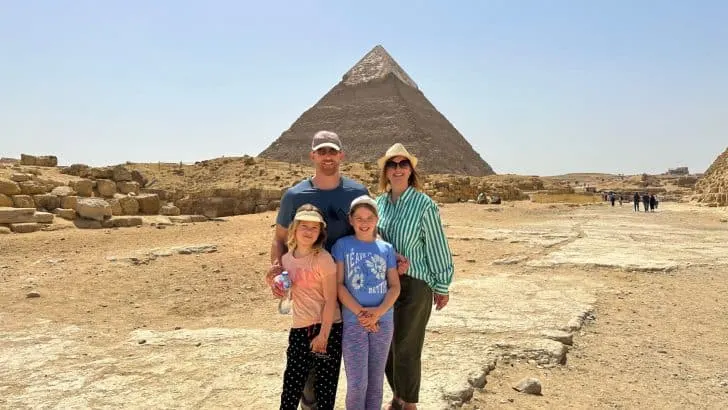If you’re considering visiting Egypt with your family it’s important to go with your eyes open. It is full of magical places. But it is not Disneyland.
Ancient Egypt was an advanced civilisation whose mind-blowing achievements are still being discovered and analysed around the world. This is the Egypt people dream about going to see.
However, modern Egypt faces many challenges. Over population, poverty, climate change and youth unemployment all factor high on its national risk register.
It’s also a Muslim country with different cultural norms to those of the European and US tourists who have made up the bulk of visitors in recent years.
*This post contains affiliate links*
Contents - jump to what you'd like to know
Our experience of visiting Egypt
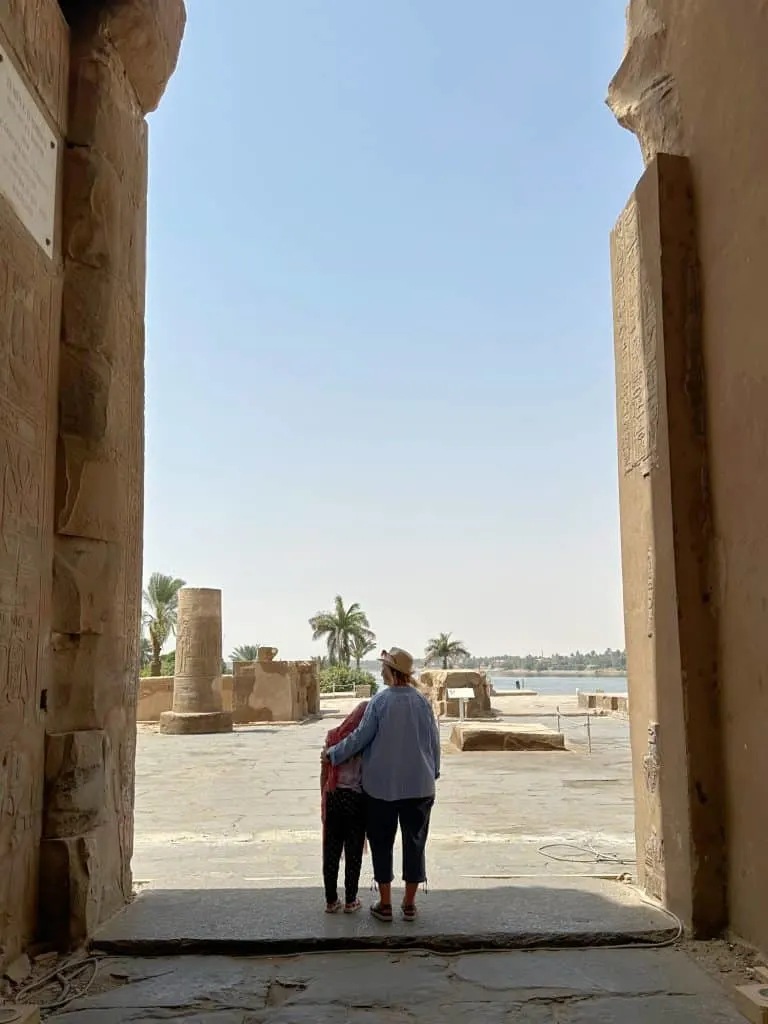
We visited Egypt in April 2023. Our trip was booked through a travel agent and included a full-time professional guide, our accommodation bookings, all our travel by road using a private mini bus, and a journey on the Egypt sleeper train.
Everything was planned for us so we are not experts in self-guided Egypt itineraries, but our experiences are relevant to families who want to try a DIY trip or a package.
Before booking our 10 day Egypt itinerary we did some research online and spoke to other families who’d visited.
We knew that tourists can be harassed at the ancient sites. We knew that women in-particular can be subject to unwanted attention. And we knew that we would be asked for tips for anything and everything.
But we still wanted to visit Egypt.
In the end I think we went over-prepared for all of the potential downsides and came away pleasantly surprised that it wasn’t as bad as we imagined.
I suspect that managing our expectations helped and I’d encourage other families visiting Egypt to do the same to avoid any disappointment.
In this post I’m sharing some of the things we learnt about visiting Egypt. It includes:
- Is Egypt safe to visit?
- Do you need a visa to travel to Egypt?
- Flights to Egypt
- The best time to visit Egypt
- Things to know about visiting Egypt during Ramadan
- Currency and tipping in Egypt
- Handling souqs and street hawkers
- What to wear in Egypt
- Journey times between ancient sites
- Family accommodation
- Security in Egypt
- What to expect on Egypt’s roads
- What not to do in Egypt
- Where to visit in Egypt with kids
- What to pack for travelling to Egypt
Things to know before travelling to Egypt
Here’s some information to help you manage your expectations before visiting Egypt. Some of it is very factual, while other parts are based on our personal experience.
1. Is Egypt safe to visit?
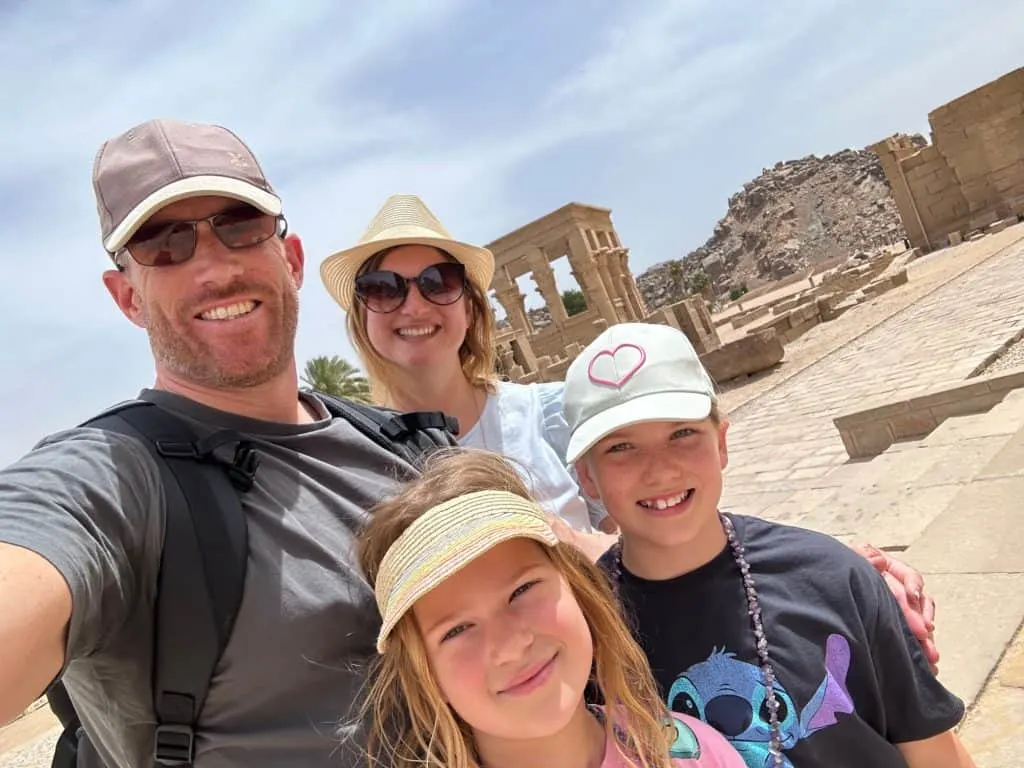
This was the question I was asked most on Facebook and Instagram before, during and after our trip.
It’s a fair ask.
Egypt ranks in the top 20 countries in the world affected by terrorism. And the UK government advises against travelling to some areas within the country.
In general there is a heightened risk of terrorism in Egypt with 30 recorded incidents in 2022. You can see how this compares with other countries in the Global Terrorism Index.
The conflict in Sudan to the south might also make people think twice about how safe it is to visit Egypt.
North East Africa is a region with significant political unrest. The Foreign Commonwealth Office is constantly updating its travel advice.
Feeling safe in Egypt
Feeling safe is a very subjective thing. Our personal experience was that we felt very safe.
We had our own guide with us the whole time and we didn’t touch on any of the places the UK government advises not to go. We also knew our travel agent would react to the latest travel guidance.
If you do have safety concerns then we can recommend booking your tour through a travel agent so that you have your own guide and every part of your trip is arranged in advance.
We used and had a great experience with Families Worldwide, a UK-based tour company. Stubborn Mule and Intrepid Travel also offer Egypt tours for families.
Just like you should every time you go on holiday, make sure you have a good travel insurance policy* that adequately covers the country you are visiting and all of the activities you may do.
2. Do you need a visa to travel to Egypt?
Yes. Each person visiting Egypt must have a tourist visa unless you are only staying in the Sharm el Sheikh, Dahab, Nuweiba or Taba resorts and are there for no more than 15 days.
Visas to travel everywhere else in Egypt cost $25 per person and can be bought online on the Egyptian Government’s official visa website. Ours took 24 hours to come through.
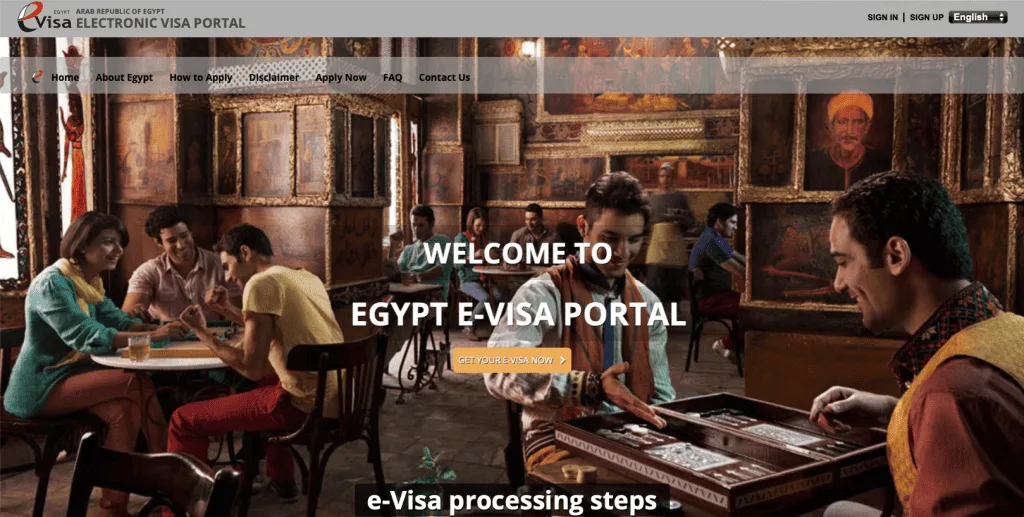
The website is a little clunky, so be patient.
You can also buy visas at the airport before you go through immigration. I prefer to get this kind of detail sorted well before we land.
3. Flights to Egypt
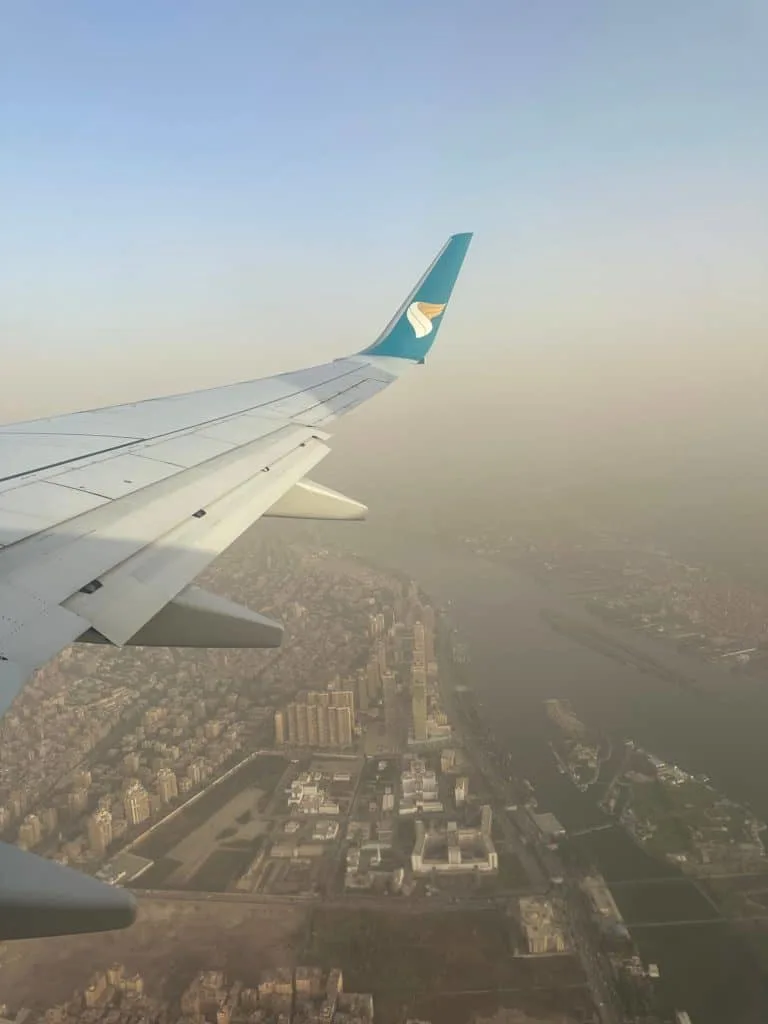
We booked our own flights to Egypt using Skyscanner to check the best routes and prices. There are plenty of direct flights to Cairo International Airport from the UK.
If you want to skip Cairo and hop on to Luxor, Aswan or the Red Sea you’ll need to get a connection. Egypt Air is the main airline for internal flights.
We found their website to be a bit ropey and their customer service was really poor when we wanted to make a change to our flights.
The flight itself – an internal trip from Hurghada to Cairo – was much more pleasant than the pre-travel admin.
If you book your travel itinerary through a tour operator they can organise all your flights as part of your package. We had to book our own as we were travelling from outside the UK.
4. Getting around Egypt
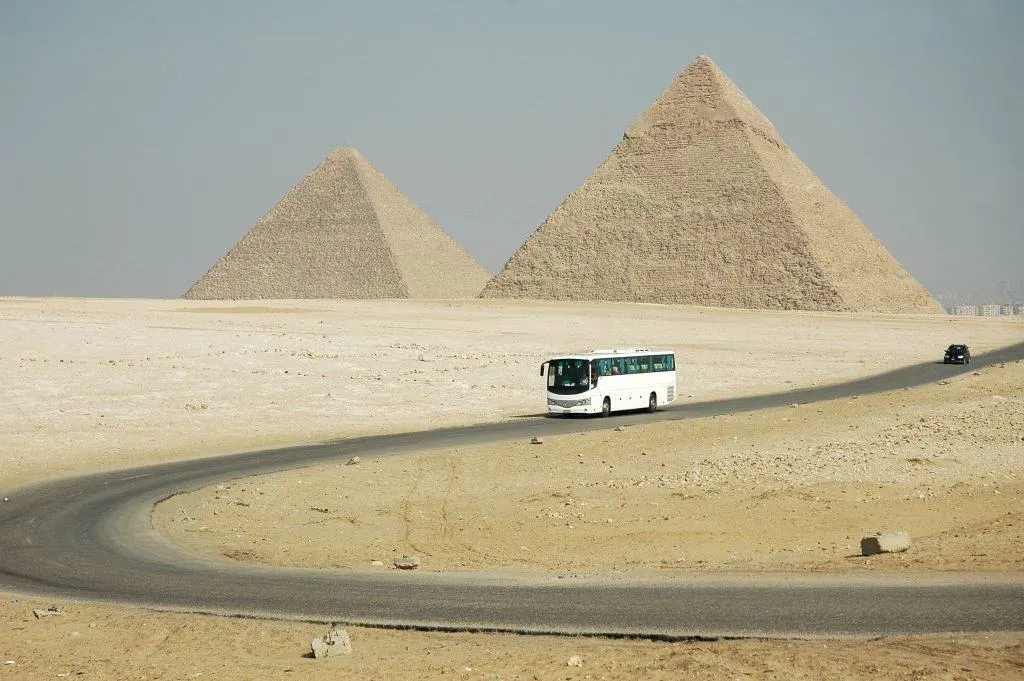
Our transport was included as part of our tour but if you are arranging your own itinerary it’s a good idea to get your tickets or drivers booked in advance.
Backpacking families have got this licked whichever country they are visiting. If you’re wondering how they do it without local contacts, websites like Bookaway are the key.
It helps you easily find options to get around – buses, trains, flights or taxis – from A to B for your family group and budget.
Check out the transport options for routes around Egypt*.
5. The best time to visit Egypt
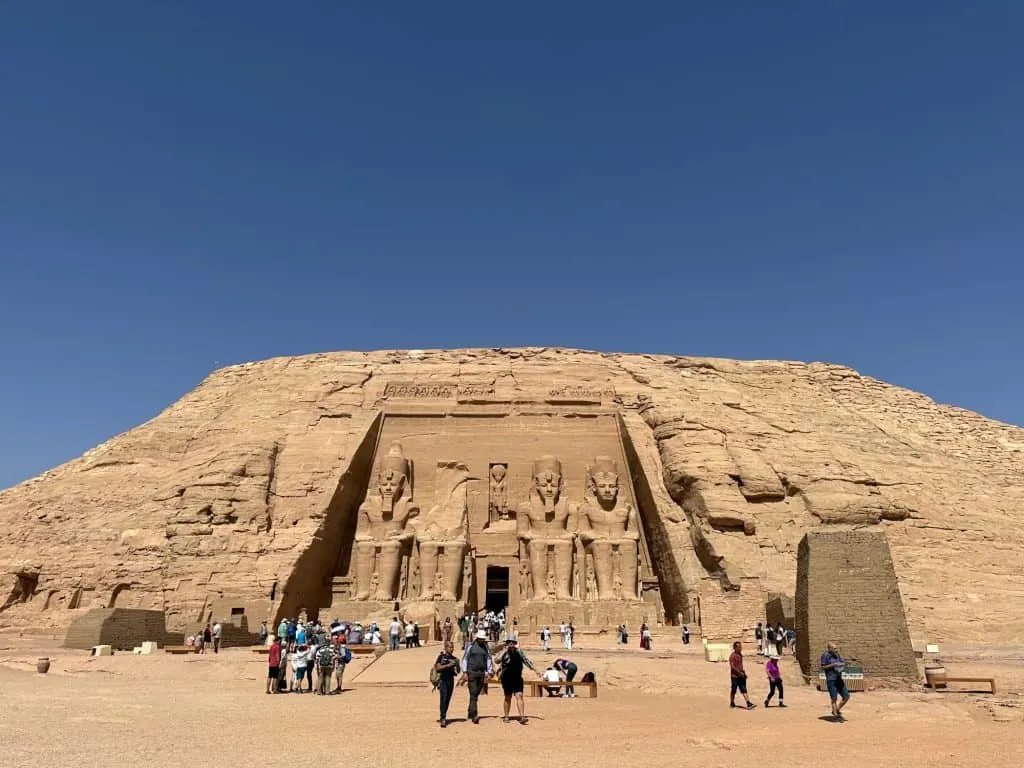
We visited Egypt at the beginning of April during our children’s Easter school holidays.
The temperature in Cairo, on the Mediterranean coast in Alexandria and on the Red Sea was below 30°C in the middle of the day, so sightseeing was possible, although we had lots of water with us and sought out shade when we could.
When we travelled south to Luxor and Aswan the daytime temperature peaked at 35°C, which was less comfortable. We still managed to spend a few hours exploring the ancient sites but the AC of our private mini bus was a very welcome relief.
Between May and September the tourism season in Egypt winds down due to the heat. Temperatures rise above 40°C, which can make sightseeing difficult, particularly with children.
By October Egypt’s average temperature has slipped back down to 30°C and in December through to February the thermometer lingers at around 20°C making exploring much easier.
So if you want to avoid the worst of the North African heat December and February half term are the best times to visit Egypt for sightseeing.
October and April are the optimum times if you want to combine seeing the ancient wonders with a beach holiday at a Red Sea resort.
As Egypt is a predominantly Muslim country, you should also be aware of the timing of Ramadan.
6. Visiting Egypt during Ramadan
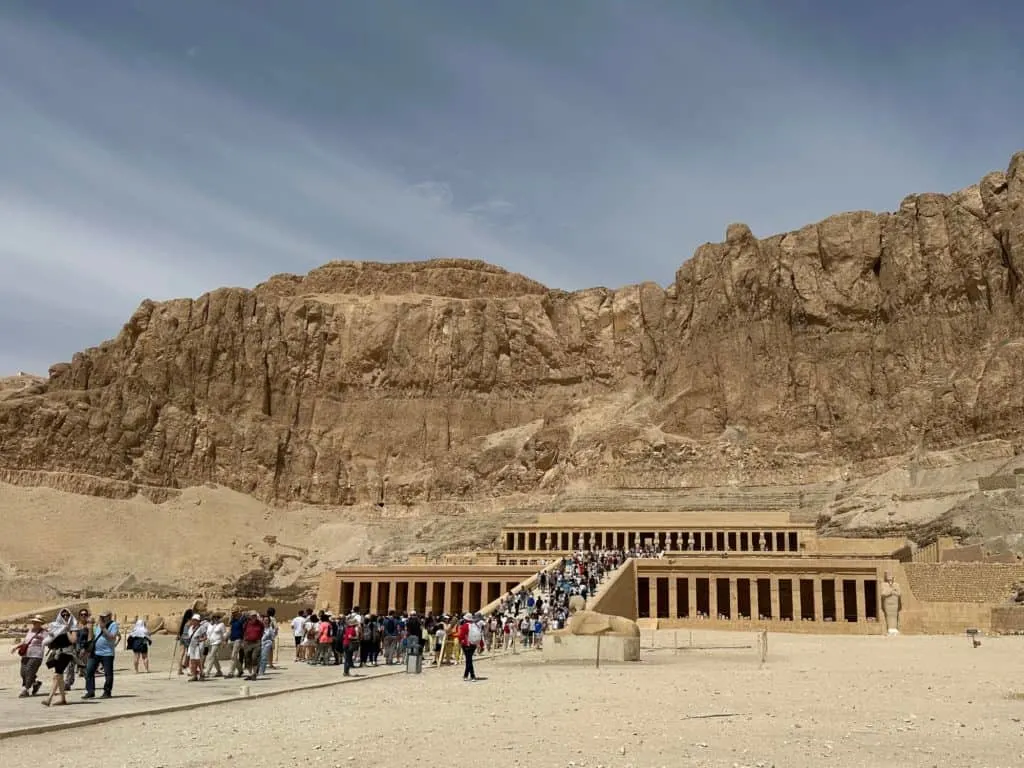
We visited Egypt during the Muslim celebration of Ramadan. We live in Oman so we knew some of what to expect but found Egypt to be much more liberal in how the rules were applied for tourists.
This is why I wanted to share a few tips based on our experience of travelling to Egypt during Ramadan. Each Muslim country has a slightly different approach, particularly if tourism plays an important role in its economy.
Our guide told us that in Egypt they wanted to encourage tourists to continue visiting during Ramadan, so allowances were made for them.
In some countries, tourism is not so well developed and non-Muslims must observe the customs of Ramadan in all public spaces. Here’s what we’ve experienced in Oman during Ramadan.
So, if you visit Egypt during Ramadan, what do you need to know so you can respectfully observe its region and culture?
Here’s what we learnt:
Eating and drinking during Ramadan in Egypt
Eighty percent of cafes and restaurants in Egypt are closed during daylight hours in Ramadan.
The ones that are open are there for tourists, not locals, so we found them to be either very quiet or only serving coach tours.
All the cafes at the ancient sites, where you can buy drinks and snacks, were open.
Our guide found us restaurants where we could have a meal at lunchtime. He always called ahead to check they were open. Some opened just for us.
If you were organising your own tour during Ramadan finding places to eat during the day could be difficult.
There was a definite difference in quality between the places we ate during the day and the places our guide was able to take us to in the evenings. Every experienced traveller knows the best food is served at the places where locals eat. But during Ramadan these places are closed during the day.
Hotels continue to serve breakfast, lunch and dinner. They and any guides you employ during your trip may also be able to recommend places to eat. Speak to them beforehand to see what’s possible.
Very few restaurants and bars, apart from the ones in hotels, will serve alcohol at all during Ramadan.
Can you eat and drink around your guide?
If you have an Egyptian guide it is very likely they and your driver will be fasting.
Ours was happy for us to eat and drink on our mini bus and while out and about with him. This was a relief as it helped us to keep on top of the kids’ daily snack quota.
Having said this, I don’t know if every guide would be comfortable with this.
If you intend to use multiple guides and drivers I’d recommend broaching the subject of eating and drinking when you first speak to them. Are they happy for you to do this around them or would they prefer you to hold off sipping water or nibbling on a snack until a certain point in your tour?
This is a polite and will be appreciated. I suspect most professional guides won’t mind at all.
What to wear during Ramadan
In general, it is respectful to cover your shoulders and knees while in Egypt. During Ramadan I’d go further and wear long sleeved tops and trousers when anywhere other than the tourist sites.
If you are visiting a mosque woman should also cover their heads with a scarf.
You don’t need to be so conservative when at your hotel where western standards of clothing are acceptable at all times.
I talk more about what to wear in Egypt further down this post.
Check when Ramadan falls this year.
More handy things to know before visiting Egypt
7. Currency in Egypt
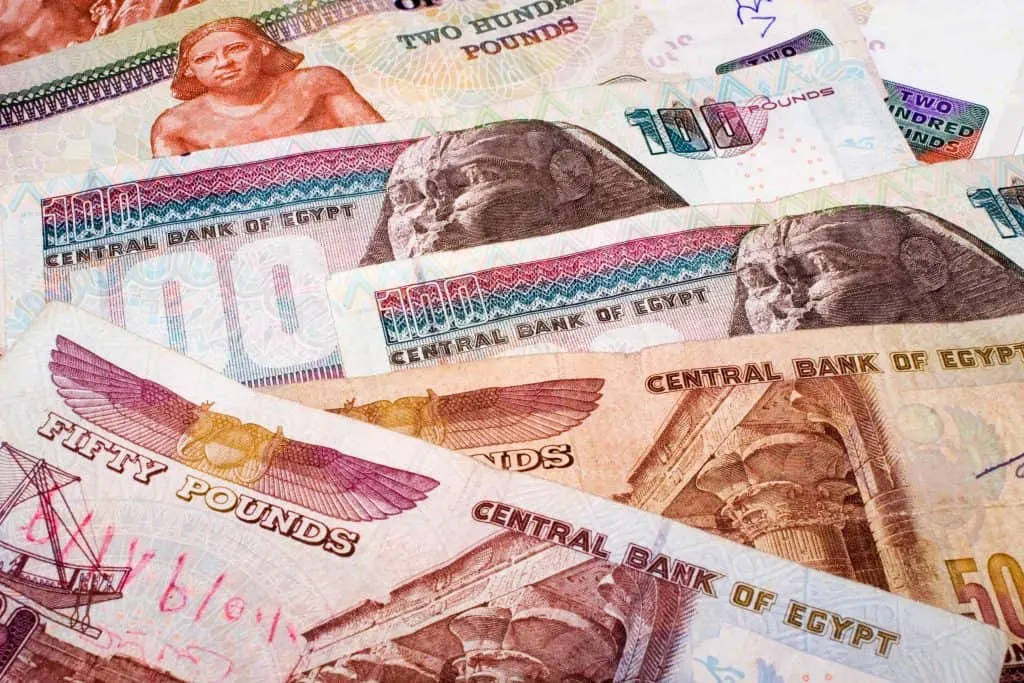
Cash is king in Egypt. And with less than 3p per Egyptian Pound (EGP) you will need a wedge of it.
We picked up our currency at Cairo Airport, and at cash machines inside and outside our hotels. It was easy to get our hands on the larger notes this way but it’s useful to have one, five and 10 EGP notes for tipping, and for the toilets at the historic sites and road side loo breaks.
You’ll have to make a purchase to get hold of these or ask if your hotel reception can swap big notes for small ones.
A lot of places, partiality souq traders, will also accept US dollars and Euros.
8. Tipping
The average monthly wage in Cairo is $100 (around £80). So elsewhere in Egypt you can expect people to have even less money in their pockets.
Tipping is not just a nice thing to do for good service, it is an essential part of the Egyptian economy.
Everyone from toilet attendants to the guys selling camel rides and the guards at historic sites who offer to take photos expect a tip.
The only place we saw signs saying you definitely should not tip was at the airport.
The good news for your travel budget is that no one expects much. You just need to have lots of small change on you.
We budgeted £50 for tips over our 10 days in Egypt and gave this to our full-time guide to distribute on our behalf.
He tipped our drivers, staff at restaurants and at hotels. He also slipped tips to cleaning staff at the historic sites. We left it to his discretion to distribute the money in the best way.
At the end of our tour we also tipped our guide. Our travel agent suggested between £2 and £5 per person per day. We went for the top end of this after seeing how hard he worked.
9. Toilets
At the historic sites the standard charge to use the public toilets seemed to be 5 EGP per person. Some places didn’t charge for children while others did.
The most we paid to use road side toilets as 10EGP per person.
If you go to a restaurant or cafe with a toilet attendant you will be expected to tip 1 to 2 EGP for each person, even if you bring your own toilet roll and you’ve bought food.
You’re less likely to find a toilet attendant in smaller restaurants, but if you pop in off the street to use the toilet expect to be charged.
On the way to the Valley of the Kings in Luxor my youngest daughter was desperate for a wee to we stopped at a cafe. The owner tried to charge us 10EGP each. I only had 5EGP on me so he had to settle for that. We’d already been at that point so there wasn’t much he could do.
10. Souqs and street hawkers
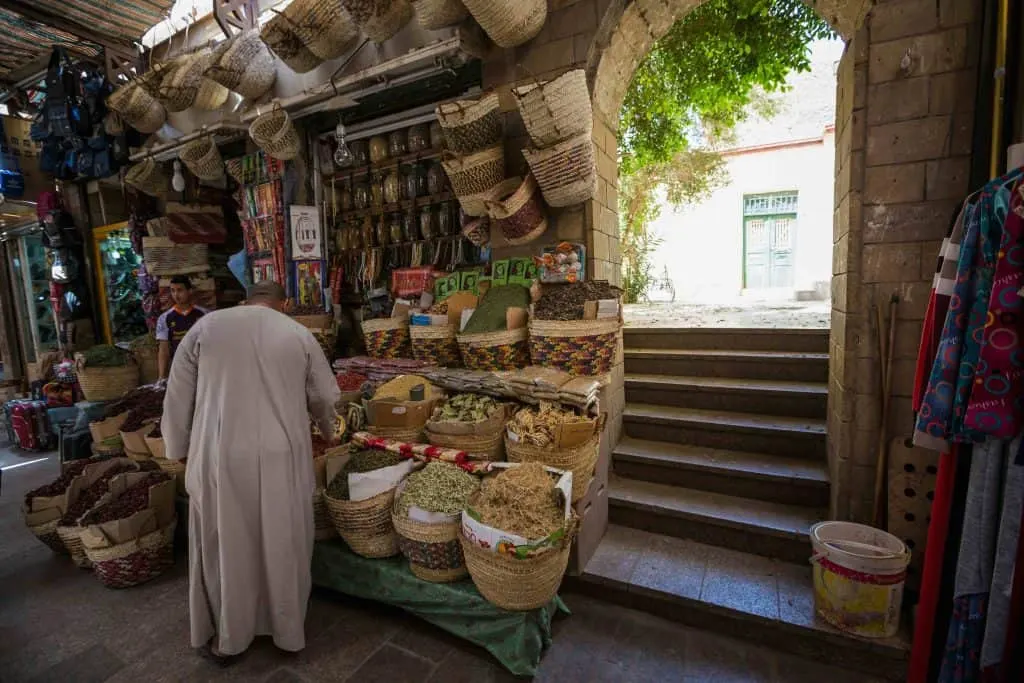
We’re no strangers to souqs as we live in the Middle East. However, we found the sales tactics in Egypt a bit more forward than in Oman where we live.
Street hawkers
You’ll be approached by people selling things and services outside the historic sites and on the streets if you are out at night.
The adults and children trying to get you to take horse and carriage rides or buy cheap souvenirs are persistent. We found ourselves saying ‘la shukran’ (‘no thank you’ in Arabic) a lot.
Having said that they were not rude and took rejection well when they finally gave up, simply walking away.
The only rude and aggressive people we saw in Egypt were other tourists.
A word of warning about souqs
The one negative experience we had was at Luxor souq. By day seven into our trip we had a bit of downtime and decided to do some souvenir shopping.
Our eyes had been caught by the loose harem pants we’d seen on lots of markets at the historic sights, so we wanted to get a few pairs.
We haggled a reasonable price and were then persuaded to buy an expensive trinket that we really didn’t want. At this point we could see things were going to spiral out of our control if we didn’t leave.
So, the souq isn’t somewhere I recommend browsing with kids.
The traders are very keen for you to visit their friends’ shops and once inside it is harder to stop them pressing small gifts into children’s hands.
If you do go, have a mission and stick to it otherwise you could come away with all kinds of things you don’t want or need. We made a quick exit after buying our off mission souvenir, which is a shame as I’d liked to have looked around some more.
As I mentioned earlier, a lot of people have asked me if we felt safe in Egypt and we absolutely did. But did we feel harassed?
This was the only time we felt really hassled in Egypt. It was our one evening out without our guide so I suspect that might have shielded us from over-zealous sales pitches elsewhere.
11. Stomach upsets
Whenever we visit a country where there’s a chance of picking up a funny tummy I usually do. It may not be a bug or dodgy food as such, but I often find my stomach is unsettled when we are travelling.
I had a rumbling during our Egypt trip but it was mild and only lasted half a day after I popped a precautionary Imodium.
Pack a packet of whatever you usually use to help settle your stomach in case one end or the other reacts to different food and water. Rehydration sachets are also handy to have in your travel first aid kit.
12. Drinking water

Bottled water is much safer to drink than tap water. Some people go as far as avoiding salads and fruit that has not been peeled, but we ate small quantities of both at our hotels.
We used tap water to brush our teeth in our hotels but avoided it altogether during our train ride from Cairo to Aswan. Even our Egyptian guide used bottled water to clean his teeth.
13. What to wear when visiting Egypt
Egypt is a predominantly Muslim country where conservative dress is expected in most circumstances.
Here’s what to wear for different activities and in different places in Egypt:
Sightseeing

As I mentioned higher up, covering shoulders and knees is expected when out in public in Egypt.
Cropped trousers, t-shirts and shirts made from cotton with robust sandals or trainers are the ideal clothes for exploring in Egypt. Don’t forget your hat and sun glasses too.
What not to wear
We saw lots of people in strappy tops and bum skimming shorts at the ancient monuments, even during Ramadan.
These skimpy outfits made me cringe at these people’s lack of cultural awareness.
Females who show their legs and shoulders in public places will draw negative attention. Unfortunately it’s a fact of life for Egyptian women. So unless you want a negative experience think a bit about your outfit.
Truth bomb: I’d also not recommend not wearing floaty dresses for sightseeing.
A lot of people do as they look dreamy in photos.
But you will get sweaty legs.
I saw one poor lady at Hatshepsut’s temple who had gathered up her long skirt and pulled it back up through her legs and into her neck line to stop her legs chaffing.
It’s also difficult to climb inside a pyramid or down into a tomb in the Valley of the Kings if you are tripping over your skirt.
What to wear in mosques and churches
We didn’t go to any religious buildings during our trip. But we know from visiting other Muslim and devoutly Christian countries that shoulders and knees should be covered in mosques and churches.
Woman should also bring a scarf to cover their hair.
What should children wear in Egypt?
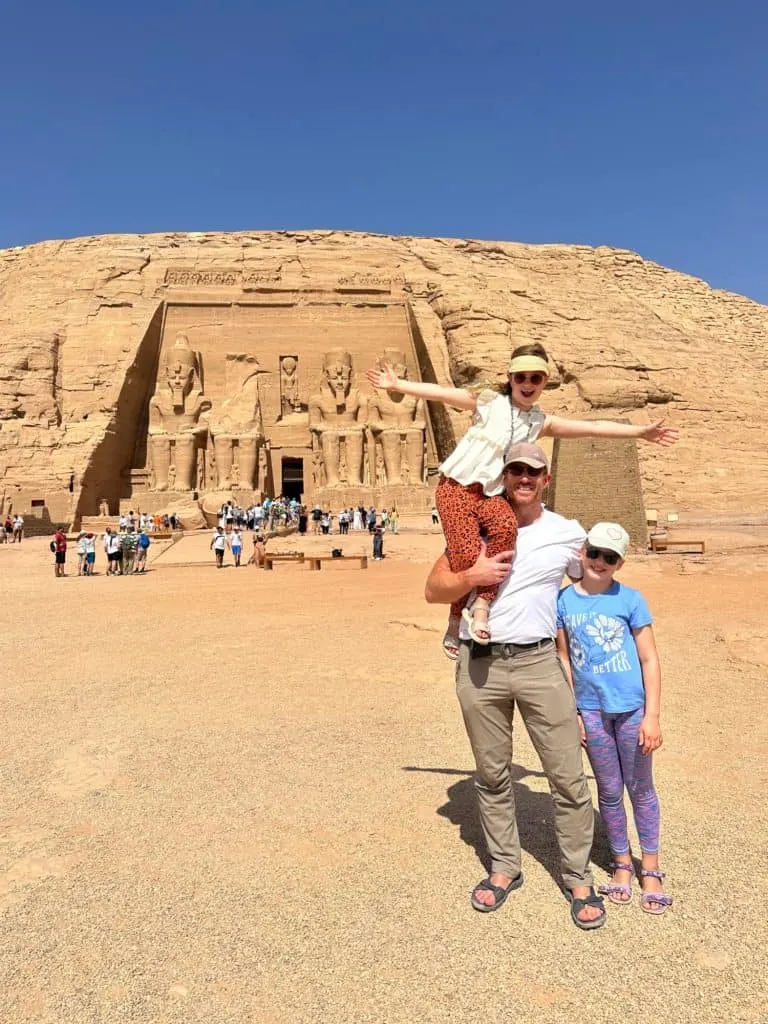
Children under the age of puberty can pretty much wear what they like. Just make sure it’s practical.
We packed short sleeved t-shirts and long cotton trousers to keep our girls comfortable in the heat.
Hats and sun glasses are also a must.
At your hotel
You can wear what you like in your hotel. Your normal swimwear is fine by the pool. Just check the dress code for hotel restaurants.
At our final hotel on the Red Sea bikinis, thongs and speedos were standard lounging attire at the beach, but tops/shirts were required in the buffet and restaurants.
If you’d like a more detailed list of clothes to wear in Egypt take a look at my suggested packing list at the bottom of this post.
14. Journey times between Egypt’s ancient sites
If you want to see a good proportion of Egypt’s ancient wonders in one trip you will be doing a lot of travel.
For this reason I’m glad we did this trip when the girls were aged 10 and nearly eight. It was tiring.
They spent a lot of time in our mini bus napping or on their tablets as the scenery – often very bland – rolled by
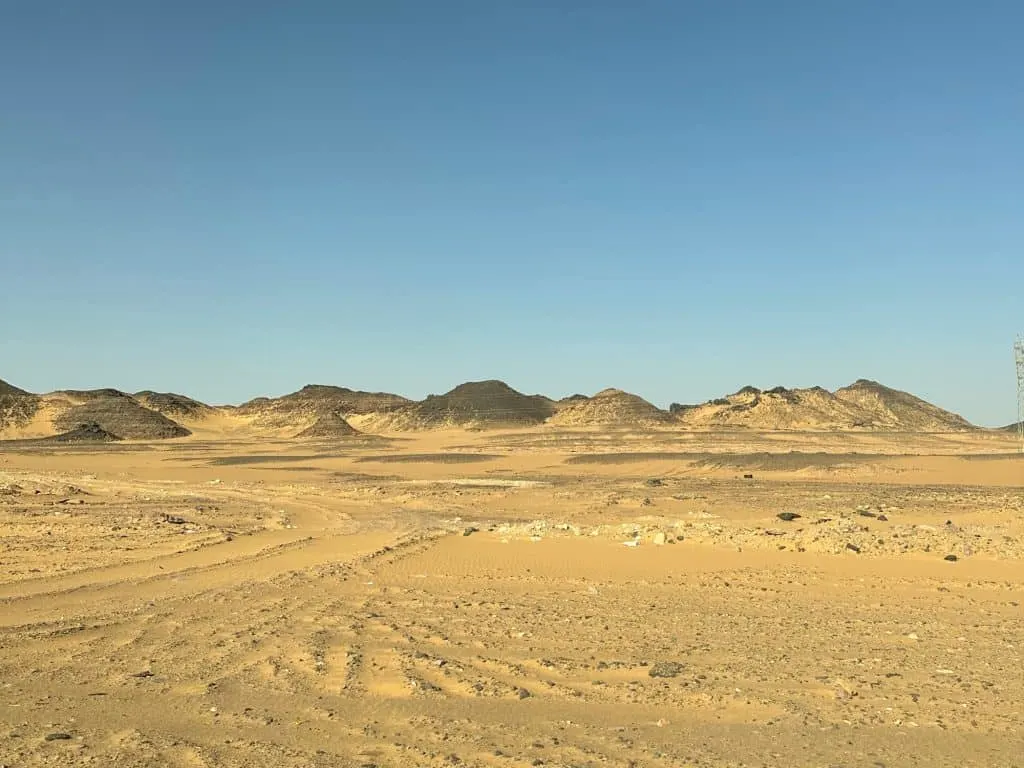
I brought a bag full of cereal bars, nuts and sweets with us and we topped this up during the trip.
Our longest travel day – aside from our 16 hour journey home – was a nine hour round trip to Abu Simbel. Seven hours of this was on the road.
There were also some very early mornings and late nights that younger children may find difficult. Our girls were pushed to their limits.
When we first looked at Egypt as a possible destination we knew we needed to add some downtime to the end of our trip for everyone’s sanity. We did seven straight days sightseeing and two full days at the end relaxing.
On reflection, if we’d had more time, I’d have added an extra day off in the middle.
15. Hotel star ratings in Egypt
Egypt has a lot of five star hotels, but they don’t necessarily match the standards of five star hotels in the UK and Europe.
We stayed in three five star hotels and one four star hotel during our 10 day trip. Two of the five star hotels were quite tired. Fixtures and fittings were worn, particularly in the bathrooms.
One of them didn’t provide a kettle in our rooms and had a something weird going on in the bathroom.
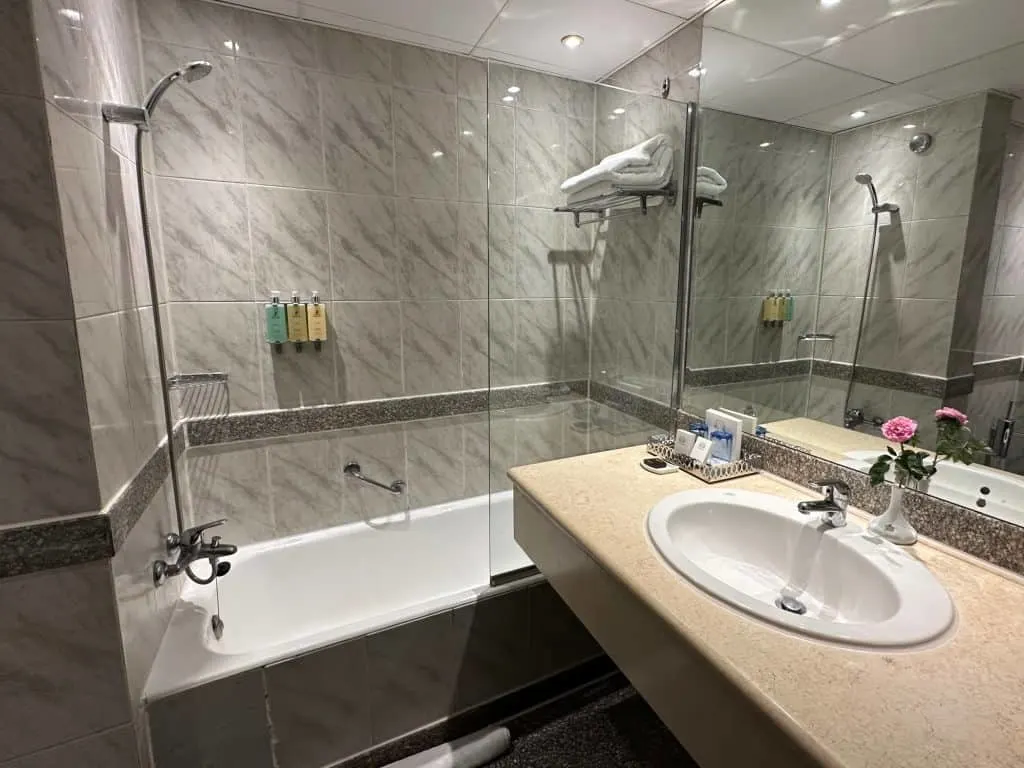
We also saw a lot of old Covid-19 signage and empty hand sanitiser dispensers at some of our hotels. Neither staff or guests were adhering to the instructions, so they were just out of date and needed to be removed.
The rooms in our four star hotel in Hurghada, which was aimed at a European market, were much better. But they didn’t have much character.

I’ve summarised the rooms, facilities and service at the places we stayed in my Egypt itinerary post.
Something else to bear in mind is that Egypt’s city hotels rarely do family rooms. You might find family suites at some of the Red Sea resorts.
We had interconnecting rooms at three out of the four hotels we stayed at and onboard the sleeper train between Cairo and Aswan.
This isn’t a problem for us – we quite liked having more space while still being able to keep an eye on the kids – but families with younger children might want to stay in a single room.
16. Security
There’s no getting away from the fact security is tight in Egypt.

You will travel through countless police check points where armed officers ask drivers who they have in their vehicle. ‘Four anglaise’ was always our drivers’ reply and away we went. Only one police officer asked for the mini bus door to be slid open so he could eyeball us.
There are armed guards at all tourist sites and each of our hotels had security people at the front gate and bag scanners in the lobby.
We found this all reassuring rather than worrying. It’s what you’d expect in a country where tourists have been targeted by terrorists.
17. Traffic and roads
The roads in Cairo are a tangle of horn happy drivers, weaving motorcycles, tuk tuks, vans overloaded with people or goods, horses and carts, and pedestrians dashing across eight lane highways. It’s quite a show!
The traffic is similar in Alexandria but much slower paced in Luxor and particularly Aswan.
The quality of rural roads in Southern Egypt is particularly bad.
After the Arab Spring in 2011 many villagers installed speed bumps and check points so they could control who came to their area. The bumps are still in place and make the rural roads uncomfortable to travel.
You’ll also see donkey drawn carts, tuk tuks and even vans loaded with camels outside the cities.
Our Egypt travel tips – dos and don’ts
Here’s some things to do and not to do to make the most of your family holiday in Egypt:
18. What not to do when visiting Egypt
Before I share our favourite experiences and the places we recommend seeing in Egypt I’m going to suggest some things not to do.
Don’t pick up a guide on the fly
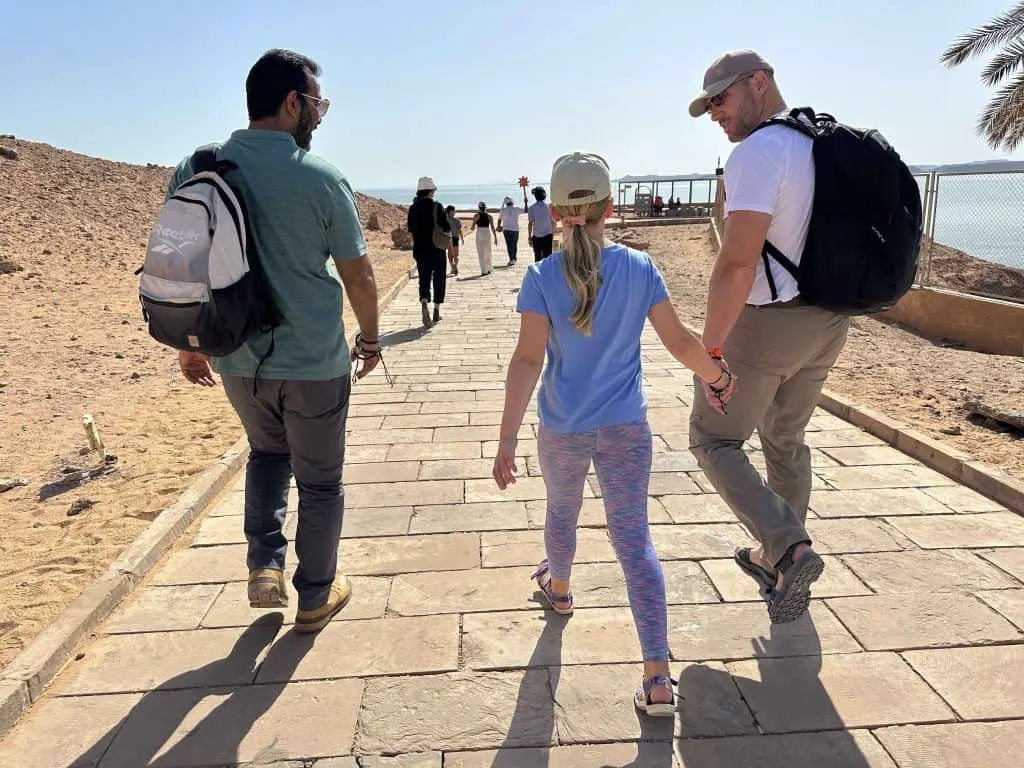
Getting everything agreed in advance means you can make sure you are happy with your guide’s credentials and the price you are going to be charged. We found this much less stressful. I’ve read plenty of stories online by people who felt they got conned by guides they’d employed last minute.
We arranged our guide through our travel agent. He studied Egyptology at the University of Cairo and was with us for the whole 10 days we were in Egypt. We weren’t taken on any unexpected ‘factory tours’, taken to places we didn’t feel safe or asked for extra money at the end.
And because we booked through a travel agent specialising in family holidays our guide was great with our kids. He entertained them interesting stories, found us shady spots where he could tell us about the temples and read the room when the kids had had enough.
Don’t bother bringing a proper camera
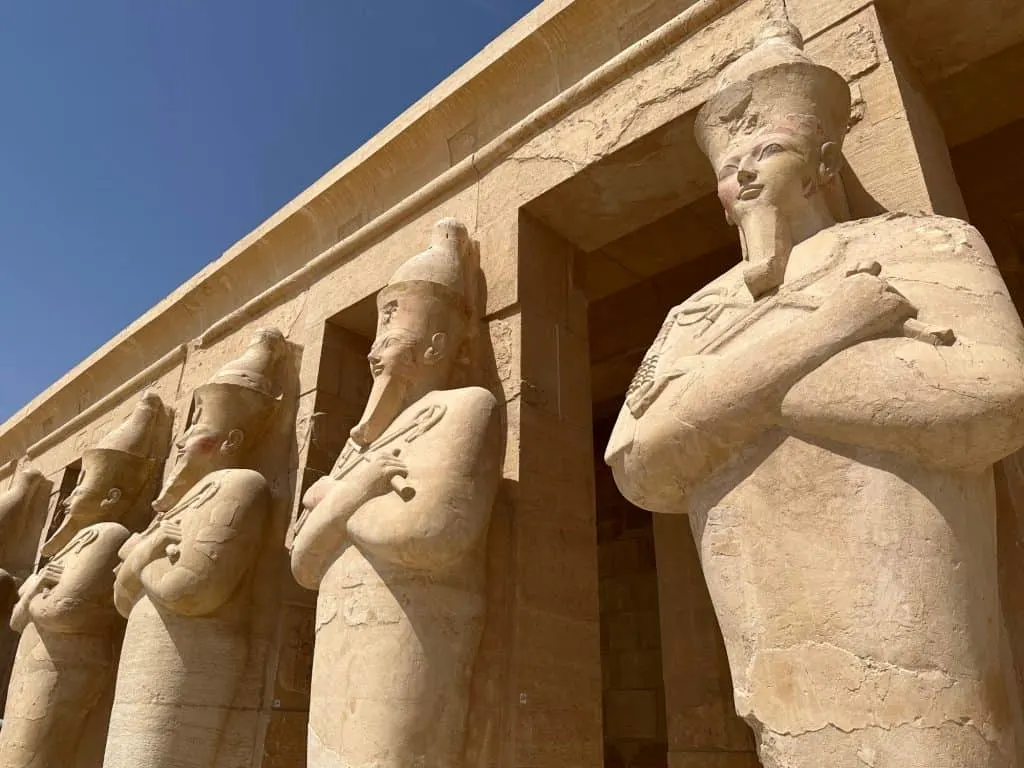
All of the ancient sites we visited charged extra if you wanted to use a proper camera.
If a guard sees you using a camera they will ask to see your ticket for it (or for a tip to allow you to use it under the radar).
For this reason, I decided to leave my DSLR at home. It wasn’t worth the faff.
All the photos and videos from our holiday in Egypt were taken on our iPhones.
Smartphone cameras can be used everywhere for free. The only tourist place photos couldn’t be taken was inside the Tutankhamun exhibition in the Egyptian Museum in Cairo.
Don’t bring a drone
It’s illegal to fly a drone in Egypt, so if you have one leave it at home.
Don’t take photos at check points
Taking photos of check points, security guards, police or official government buildings is a no-no. We were even instructed not to take pictures at Aswan Higher Dam for security reasons.
Avoid the sleeper train
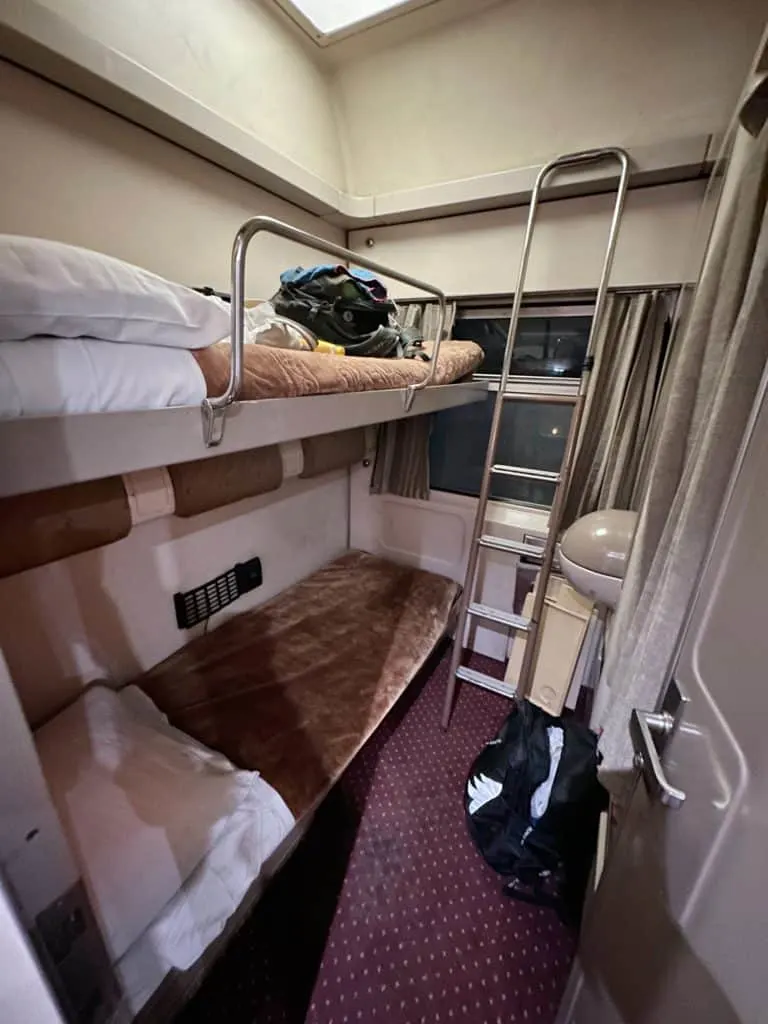
This is a tip specifically for clean freaks. If you can’t bear the thought of travelling on a less than spotless and comfortable mode of transport then the sleeper train is not for you.
Personally, I’m glad we did it but I wouldn’t travel by train in Egypt again. I’d fly or book a cruise (without the kids).
Read about our experience on the Cairo to Aswan sleeper train to decide for yourself.
Don’t touch cats and dogs
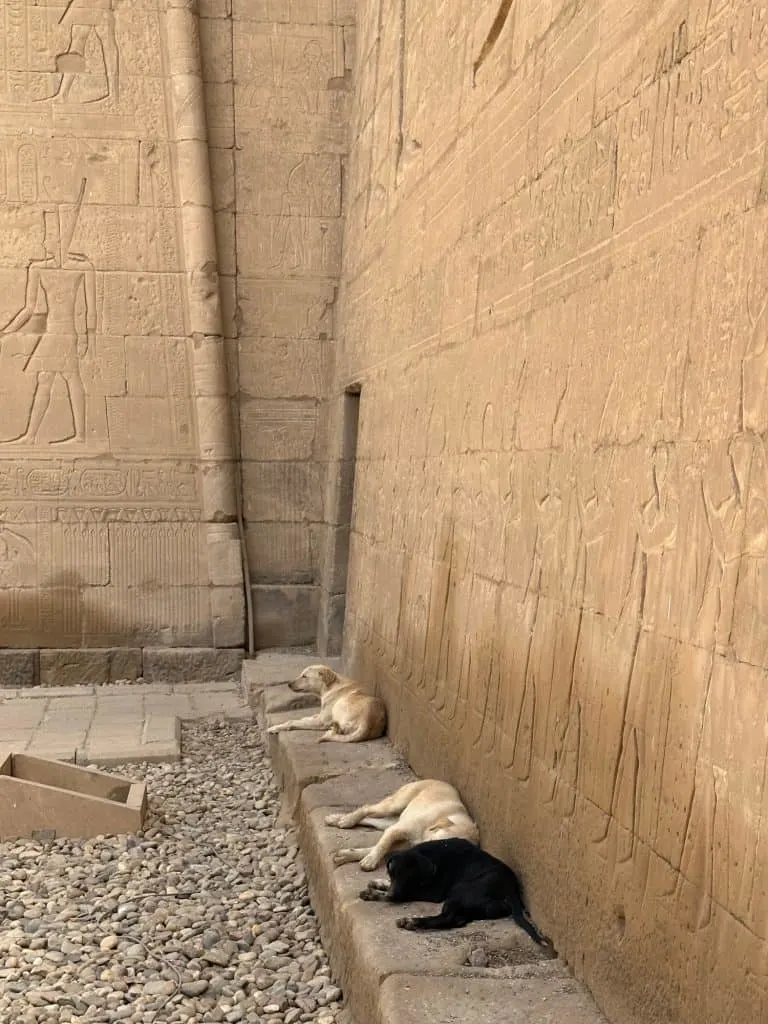
There were lots of cats and dogs at the ancient temple sites we visited in Egypt. We found this a bit surprising as where we live in Oman they would have been chased away or worse.
In Egypt stray animals are part of the street furniture. Locals feed them and leave them to their own devices. We even saw puppies playing outside the Sphinx complex.
Your kids may be tempted to pet animals but they are still wild and won’t have been vaccinated or treated for parasites. So remind animal-loving little people not to touch them, however tame they might appear.
Don’t climb on ancient structures
It’s obvious really, but you are going to get in trouble with the security guards if you start climbing all over the centuries old structures.
Don’t accept offers to see inside roped off rooms
Staff at some ancient sites will invite you into roped off areas and over barriers for a tip.
Our guide warned us about this at Hatshepshut’s temple. Sure enough, when we reached the top tier we were asked if we’d like to go around a barrier. We also saw it happening in the tombs at the Valley of the Kings.
It’s against the law for staff to let you into restricted areas, so don’t feed this illegal activity.
Don’t accept help unless you are happy to tip
If a temple guide offers to take your photo, if someone asks to carry your bag or if someone says they can show you the best view, expect to be asked for a tip.
Don’t forget you are in a Muslim country
Just remember a few simple rules in order to act respectfully and avoid the wrong kind of attention:
- Wear conservative clothing – see above.
- Don’t kiss, cuddle or hold hands with your partner in public. LGBTQ+ couples must keep their relationship secret because Egypt is not a very tolerant country.
- Don’t drink alcohol in public places. Hotels and some restaurants will serve it.
- Avoid discussing religion and politics – Egyptians are very protective of their views. NB we got away with this a bit with our guide as he was well travelled and we got to know him over a period of days.
19. Where to visit in Egypt with kids – our top five sites
Here’s a proper conundrum. What should you see in Egypt with kids?
We squeezed a lot into our 10 days and could have still done more as well as adding extra time to relax on the Red Sea coast.
I’d definitely recommenced exploring further than Cairo. The pyramids are one of Egypt’s best known attractions but there’s so much more to the country’s historic treasures.
To be honest, it was Egypt’s temples that impressed us most.
We also wouldn’t have missed Southern Egypt. Reaching Abu Simbel from Aswan is an adventure in itself and the Valley of the Kings in Luxor was much more impressive than we had imagined.
So what are the best places for families visiting Egypt? Here’s our top five:
The Pyramids of Giza

Even though they weren’t our favourite destination who could go to Egypt without seeing the pyramids? Especially with travelling with kids!
After all they are the most recognisable landmark and one many little ones will know from Go Jetters.
Add a trip to Cairo’s Egyptian Museum (or the Grand Egyptian Museum when it opens) to build a foundation of knowledge that will enrich the rest you time in Egypt.
Kom Ombo
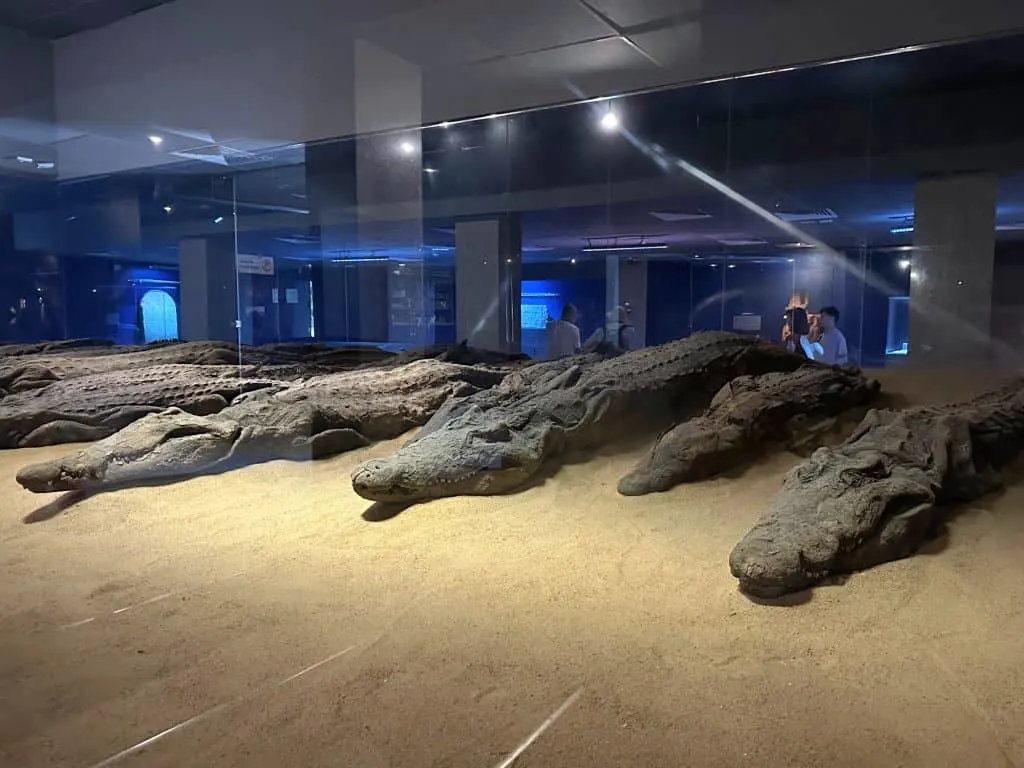
Mummified crocodiles…need I say more?
OK, I will. Kom Ombo’s collection of 300 preserved crocs were found buried at this Roman-Greaco site beside the River Nile.
The Temple itself is dedicated to two gods: Sobek and Horus.
Much of it is ruined but there’s plenty of incredible hieroglyphs to see including one depicting a mother giving birth. This kind of image has not been found nowhere else in Egypt.
The Temple of Philae

A visit the Temple of Philae requires a boat trip to the island of Agilkia.
The temple was moved here in the 20th Century during the construction of the Aswan Dam which led to the original Philae site being flooded.
It’s a beautiful temple and its location makes it an extra special place to explore.
Valley of the Kings
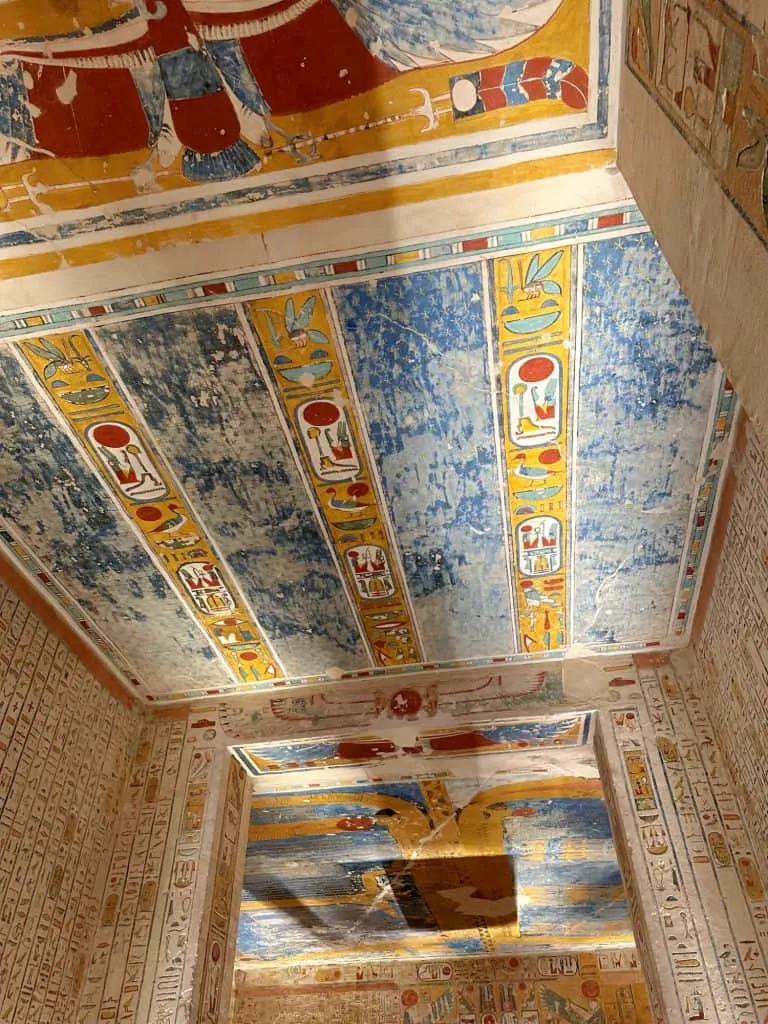
I’m not sure why but I wasn’t expecting much from the Valley of the Kings. Tunnels cut into sand with a bare chamber at the end was what I suppose I had in mind.
But the Valley offered so much more. The colours of the hieroglyphs have been shielded from the sun and grave robbers never hung around long enough to bother defacing them in the way some temples have suffered.
They are also a marvel of ancient Egyptian engineering. It’s amazing to think that the architects, artists and workers spent years creating them below the surface.
Deir el-Bahri
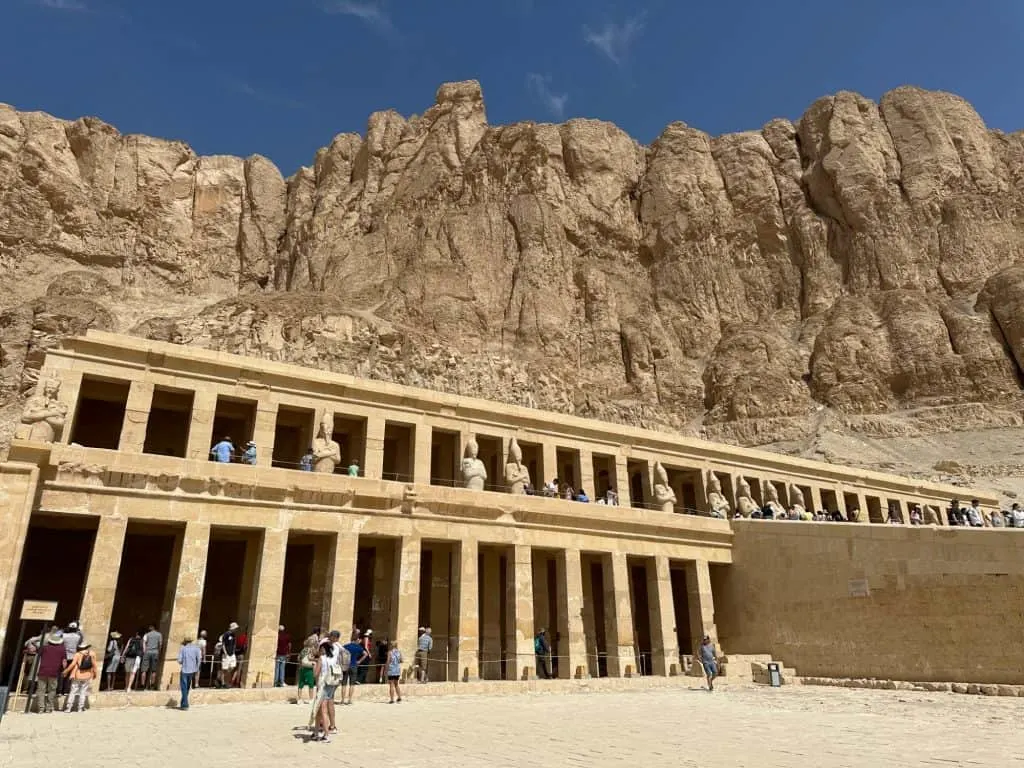
Queen Hatshepsut’s mortuary temple was my favourite Egyptian temple. Not only is it a unique design, it was interesting to experience a place inspired by such a fascinating figure in Egypt’s history.
Hatshepsut isn’t born to rule as pharaoh. But she talked herself into the job and ruled alongside her younger brother and the rightful heir, Tutmose III.
She built Deir el-Bahri temple for the god Amun and, according to ancient gossip, the architect was her lover. After she died and was buried in the Valley of the Kings he had a tunnel built from his own tomb to hers.
Bonus place: Abu Simbel
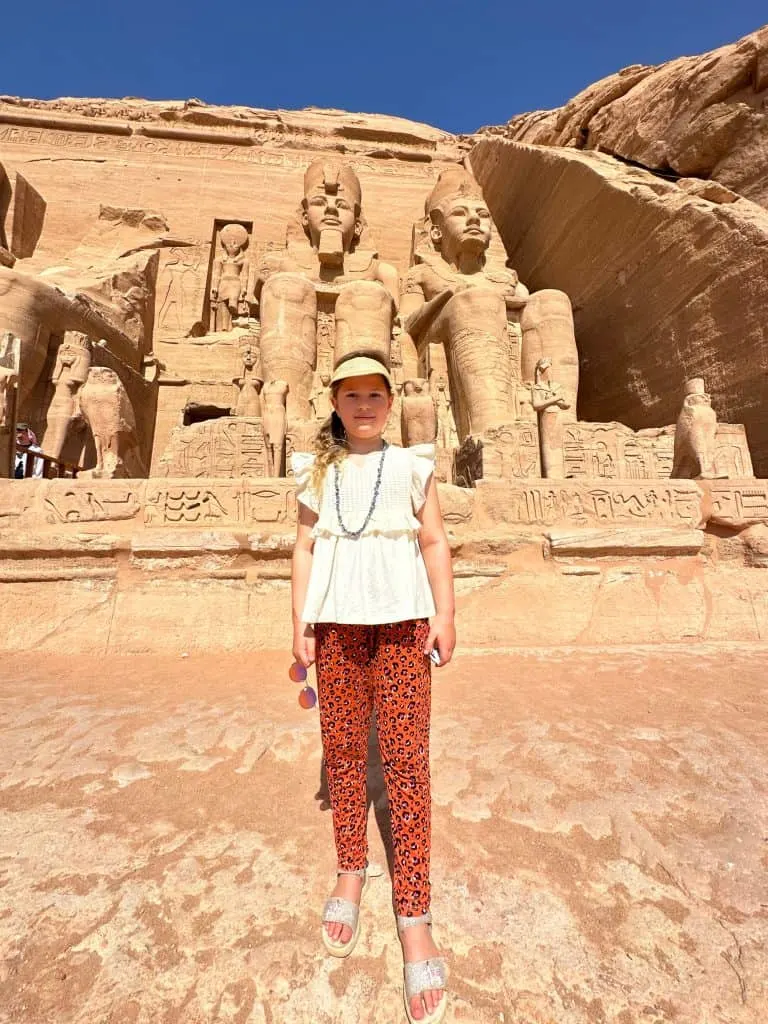
OK, so I couldn’t miss this one off. The temples of Rameses II and Queen Nefertari on the edge of Lake Nassar are incredible. BUT! It’s a long drive and families with young kids might find it too much.
We visited as a day trip from Aswan which meant setting off at 4.30am and seven hours in our private mini bus. If you do visit Abu Simbel, take a private tour to maximise your comfort.
Also plan in some down time on either side and pack all the snacks!
Find out more about each of these places and all of destinations we visited by reading about our 10 day Egypt itinerary.
20. What to pack for visiting Egypt
By now I hope I’ve answered a lot of your questions about visiting Egypt and you’re ready to pack your bags. But what should you take?
Here’s my packing list including what you’re going to need while you’re travelling and sightseeing:
Travel documents
Here’s the important paperwork to bring with you:
- Passports – they need to be at least six months in date from the day you arrive. Check the gov.uk website for the latest entry requirements and travel advice.
- Your travel insurance – I always have a digital and printed copy with me.
- Your visas – when you apply online you are instructed to have printed copies with you.
- Currency – we couldn’t get hold of any Egyptian Pounds before we travelled so brought some spare US dollars with us. We picked up more cash at the airport and other cash machines.
Hand luggage
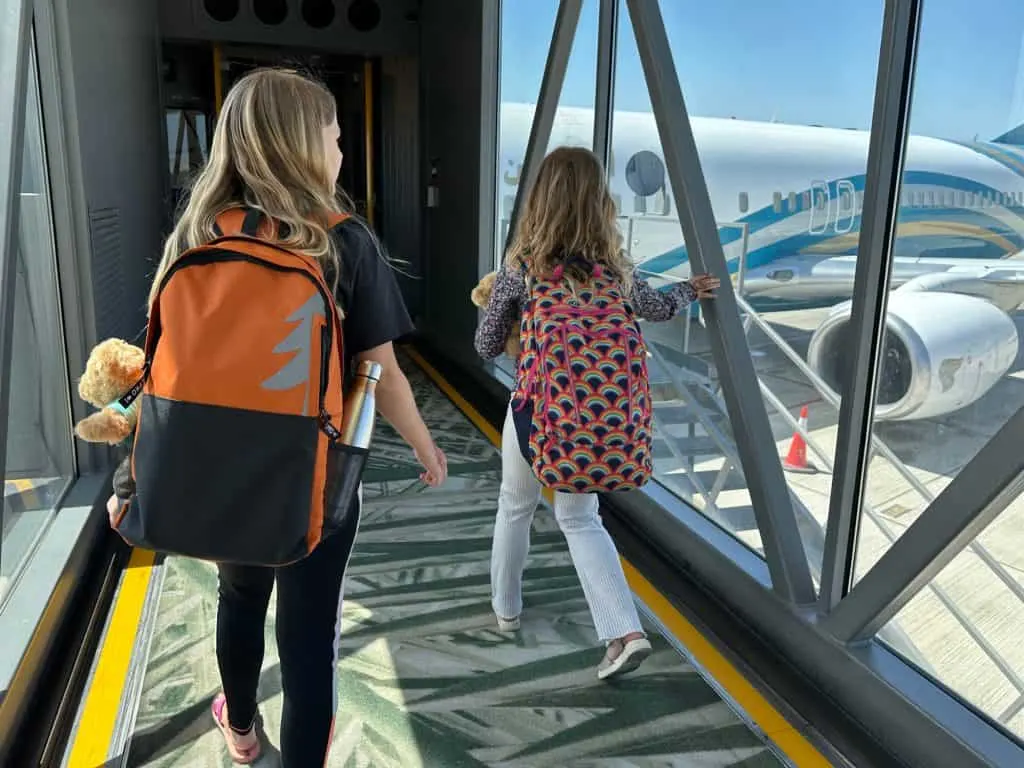
As well as taking three flights we were on the road a lot during our 10 days in Egypt. So we each had a carry on sized bag full of entertainment and things we wanted close to hand.
We took a variety of bags. Mr Tin Box has been using his versatile travel bag the Osprey Farpoint for years, the 10-year-old and I took OLPRO rucksacks*, and the seven-year-old, who loves to be different, had her rainbow pattern Landsend rucksack.
Here’s what we packed in our rucksacks:
- Reading books
- Note book
- Pencil case
- Tablet and earphones
- Snacks
- Squishaboo/travel pillow
- Tissues
- Hand sanitiser
- Reusable water bottle
- Cuddly toys
- Hat
- Sun glasses
- Travel documents
Main luggage packing list for visiting Egypt
Here’s the clothes we each packed in our main bag for sightseeing and hanging out at our hotels:
- Two pairs of cotton/light trousers
- 10 cotton t-shirts or shirts for day time
- 3 evening outfits – longer is more versatile for using inside and outside your hotel
- Light jumper
- 12 pairs of underwear
- 2 swimsuits with long sleeves or separate rash vest
- Sarong or beach shirt/dress
- Hat
- Sunglasses
- Walking sandals or trainers
- Flip flops
- Evening shoes
Here’s the other essentials we packed:
- Toiletaries
- Small first aid kit including travel sickness and Imodium tablets
- Wet wipes
- Packets of tissues
- Phone and tablet charger leads
- Battery packs
- Power adaptors
Of course if you want to travel super light you can cut back on some of the changes of tops and underwear and wash them as you go.
However, we weren’t staying at any of our hotels long enough to have our clothes laundered and I didn’t fancy hand washing in our downtime.
21. Egypt books for kids and families visiting Egypt
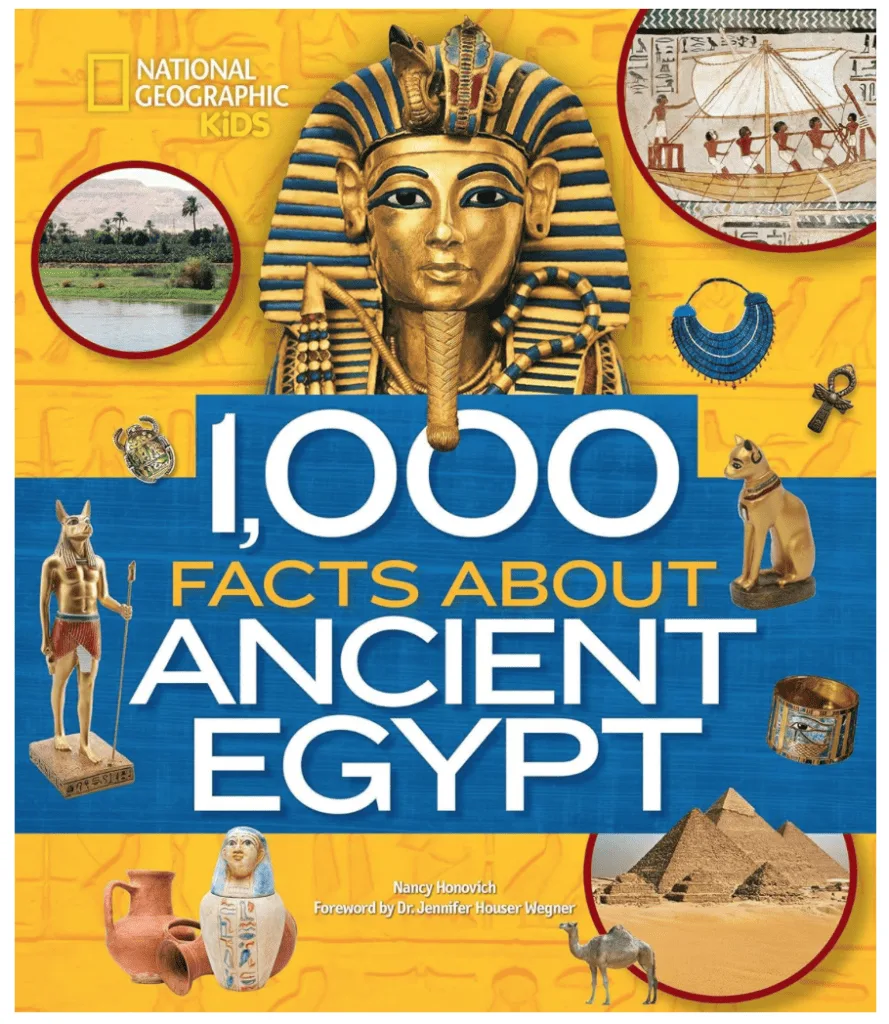

We gave each of our girls a book about Egypt before our trip. It was a great way to get them excited and remind us all about the extraordinary places we were lucky enough to be visiting.
We can personally recommend National Geographic’s Ancient Egypt: Level 4* book for children aged seven and up and National Geographic’s 1,000 Facts About Ancient Egypt book for bite-sized information to share with children of all ages.
Younger children might prefer a sticker book. The British Museum* does a lovely one that allows kids to add stickers to Egyptian scenes. And here’s plenty a short tales for young readers in Meet the Egyptians*, which is part of the Horrible Histories book series.
If you’re looking for book about Egypt for yourself I can recommend Lonely Planet*. There’s a new travel guide for Egypt coming out in November 2023. You can pre-order* it now.
We visited Egypt in April 2023 and these tips are based on our personal experience then.
Have you visited Egypt? What was your experience? Or are you on your way? Let me know if there’s anything you’d like to know.
Here’s some more posts you might like to read:
Disclosure: this post contains affiliate links marked with *. If you click on one of these and make a purchase I may earn some commission. This does not affect the price you pay.

